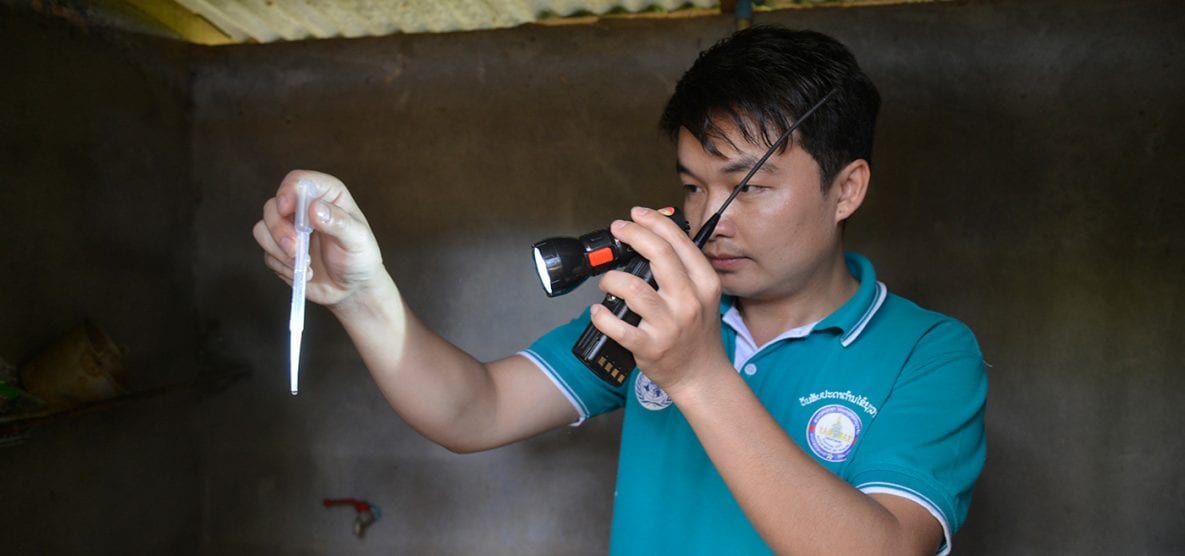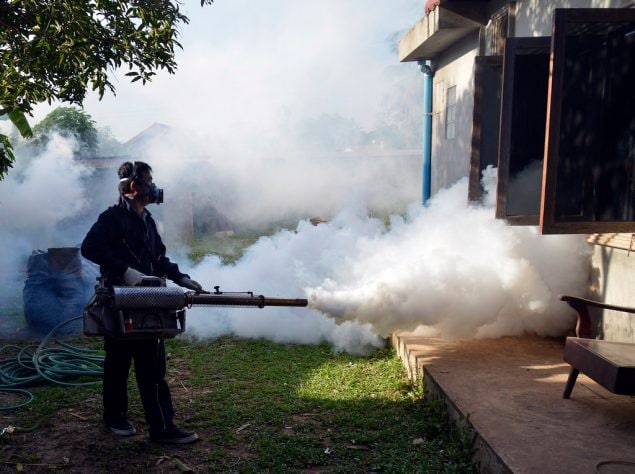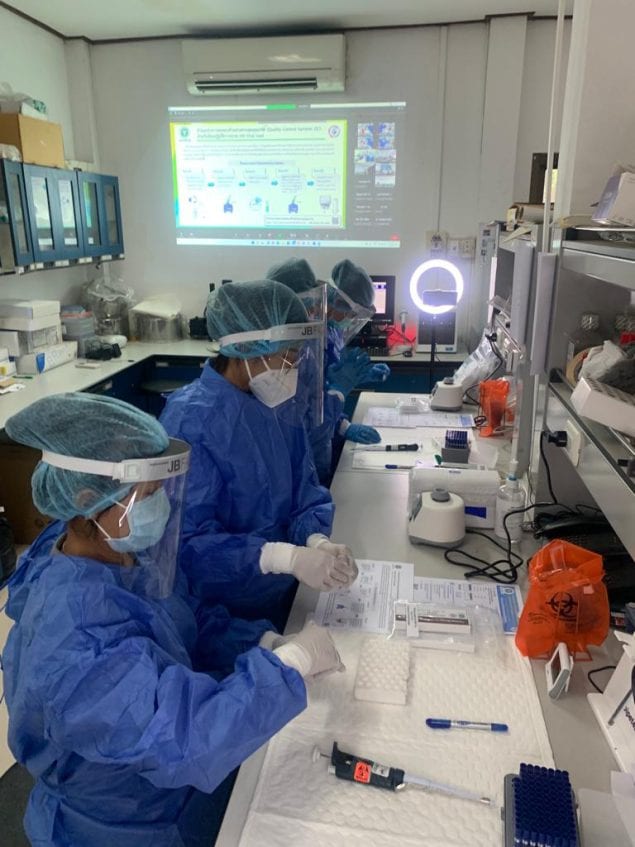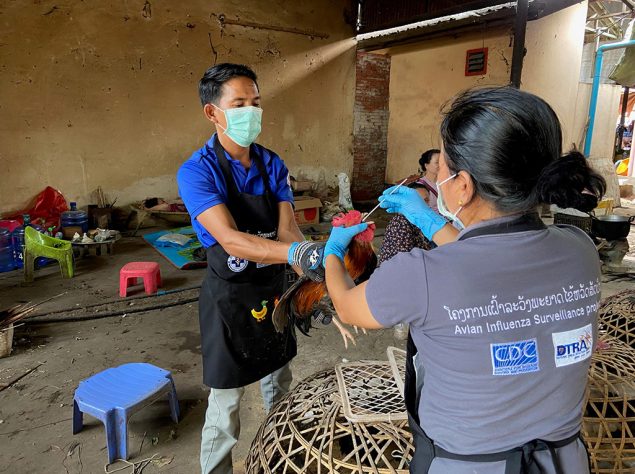CDC in Laos

A Laos Field Epidemiology Training Program (FETP) trainee examines equipment during an outbreak investigation. Photo by Billy Weeks/TEPHINET
The Centers for Disease Control and Prevention (CDC) has worked with partners in Laos since 2006. CDC works with the Lao Ministry of Health (MOH) to address HIV and influenza and strengthen laboratory systems, surveillance, and workforce capacities to respond to disease outbreaks.
Global Health Security

Laos FETP trainee spraying pesticides to control insects. Photo by Billy Weeks/TEPHINET
CDC’s global health security efforts help bolster Laos’ ability to prevent, detect, and respond to infectious disease outbreaks before they become global epidemics. CDC works with local, regional, and global organizations to support emergency response, surveillance, laboratory systems, and workforce development. These efforts aim to help the country reach the goals outlined in the Global Health Security Agenda (GHSA).
Field Epidemiology Training Program (FETP)
In Laos, CDC provides technical support to strengthen epidemiology capacity through the FETP. The Lao FETP is a one-year program that trains disease detectives to prevent, detect, and respond to public health threats. It is organized into three modules, each consisting of one month of practical classroom instruction and three months of field work. The Lao FETP was established in 2009 with support from WHO and CDC and has a national network of over 100 graduates.
Border Health
CDC partners with the Lao MOH to control and prevent the spread of infectious diseases among travelers and mobile populations who cross international borders. The team supports the development of a quarantine health program at key international Points of Entry (POEs) like airports and land crossings on the border.
Emergency Response
The COVID-19 response has been a hallmark example of how CDC’s partnership with the MOH is key to building a successful response to a global pandemic. In partnership with multilateral and non-governmental partners, CDC:
- Provided laboratory technical expertise for genomic sequencing of SARS-CoV-2
- Supported COVID-19 testing
- Helped integrate COVID-19 surveillance into the influenza sentinel surveillance system
- Collaborated on border health strengthening measures
- Developed tools, materials, and guidance on how to safely continue HIV testing and treatment during the pandemic
CDC biosafety experts supported a training program for biosafety cabinet certification. 4 of the 10 trainees became internationally certified biosafety cabinet certifiers
CDC’s One Health Program conducts monthly avian influenza surveillance in poultry in 6 high-risk provinces. This surveillance has helped detect infections in poultry and wild birds due to avian influenza subtypes H5N1, H5N6, and H9N2
The CDC-supported Lao FETP received global recognition for its contributions to a successful response to a vaccine-derived polio outbreak in 2014-15. The program supported the Lao MOH with the outbreak investigation, set up surveillance and control systems, and provided polio vaccine and health education in rural communities across the country
CDC partnered with the Lao MOH to revise communicable disease regulations and tabletop exercises of cross-border COVID-19 scenarios. These activities focused on assessing preparedness and response mechanisms for public health emergencies, improving communication and coordination, and increasing capacities of health workers at POEs
Enhanced public health emergency control and response at POEs resulted in emergency response plans, which lay the groundwork for successful responses in the future. In designated regions, Laos now has active emergency response plans for malaria and pandemic influenza
HIV and Tuberculosis (TB)

Laboratory technicians participate in CDC-supported trainings to increase their skills in performing external quality assessments.
Through the U.S. President’s Emergency Plan for AIDS Relief (PEPFAR), CDC supports life-saving activities for people living with HIV in Laos. CDC partners with the MOH and the WHO in five provinces with high HIV burdens— Vientiane Capital, Savannakhet, Luangprabang, Luangnamtha, and Champasak. CDC offers scientific and technical expertise to strengthen the health workforce’s abilities to improve data quality and analyze HIV program data, which helps provide the evidence base for the integration of new interventions and systems into national HIV guidelines. CDC’s goal is to promote and demonstrate sustainable epidemic-control strategies that can be replicated, integrated, and scaled-up into existing health systems by the Laos government.
CDC’s PEPFAR-funded initiatives focus on key populations including, men who have sex with men, transgender women, and people living in areas with high disease, disability, and death related to HIV. CDC supports projects that promote early diagnosis of HIV, high quality HIV testing and diagnosis, strengthened and rapid treatment initiation, and sustained viral suppression. CDC also promotes the establishment of— and adherence to— quality improvement standards for HIV care, treatment, and laboratory services, and enhanced disease surveillance and monitoring systems.
Key CDC activities include:
- Increase identification of undiagnosed HIV patients through HIV index testing (which involves identifying current and former partners and household members of people living with HIV)
- Enhance patients’ understanding of antiretroviral treatment (ART), reduce delays in ART initiation, and increase adherence, retention to care, and viral suppression
- Expand access to treatment and viral load testing by decentralizing services to point-of-care sites
- Strengthen clinical management for patients living with both HIV and TB or other opportunistic infections
- Improve the quality, coverage, and monitoring of HIV rapid test external quality assurance programs in national laboratories
- Monitor recent infection surveillance to better tailor and focus interventions and improve overall response
- Strengthen data information systems and HIV program monitoring
- Strengthen technical collaboration with other partners, including the Global Fund
- Support a phased transition to a sustainable government-led response
Since 2018, Laos has used domestic funds to support HIV counseling and testing programs for pregnant women nationwide. These programs resulted from a pilot project CDC supported from 2014-16 to prevent mother-to-child transmission (PMTCT) of HIV
CDC supported the development of the first electronic application for viral load test ordering and reporting, which helps improve viral load testing and monitoring in Laos. Within one year, this work increased viral load testing coverage from 67% to 88%. The turnaround time for viral load testing and reporting of results decreased from 29 to 3 days
CDC supported the first National Monitoring & Evaluation Reporting System to monitor and report on HIV testing, PMTCT, and AIDS cases reported through passive surveillance
CDC provided technical support to establish the national External Quality Assessment of HIV-related laboratory testing, such as HIV serology, viral load, and recency
Influenza

CDC-supported health workers take samples from a rooster and other birds as part of an avian influenza surveillance project.
With CDC’s support, Laos became a global leader for influenza vaccine uptake among lower middle-income countries. Laos is the first lower-middle income country to have built the evidence and policy base to move from administering donated influenza vaccines to national procurement and delivery of the vaccine. The country is set up to regularly report and rapidly respond to outbreaks of avian influenza using both human and animal health sectors.
CDC’s Influenza Program objectives in Laos include:
- Support monitoring and tracking the spread of influenza in humans and animals, with a focus on highly dangerous avian influenza. This work is crucial for preventing, detecting early signs, preparing for, and responding to severe zoonotic diseases. This also includes influenzas that originate in animals and emerging infectious diseases.
- Support priority seasonal influenza vaccination programs by enhancing surveillance and response for seasonal, avian, and pandemic influenza.
- Support influenza laboratory and epidemiologic surveillance, early warning systems, and outbreak response.
- Increase the evidence-base to inform policy decisions for influenza vaccination programs and other prevention and control programs.
With CDC support, Laos has enhanced surveillance to detect and monitor threats from novel influenza A subtypes and other emerging respiratory pathogens
CDC helped evaluate state-of-the-art devices that detect influenza during site visits and help facilitate rapid response
In 2019, CDC supported national rapid response trainings and cross-border exercises on responding to influenza viruses with pandemic potential
- 3 Locally Employed
- Population: > 7.5 million
- Per capita income: $8,150
- Life expectancy: F 69 / M 62 years
- Infant mortality rate: 49/1,000 live births
Sources: Population Reference Bureau 2022, Laos